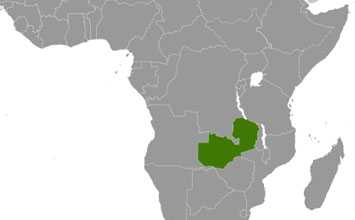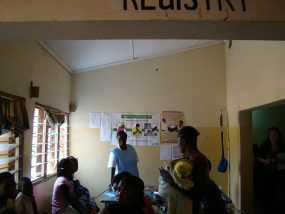
Source: Population Reference Bureau Fact Sheet, 2015
Source: GBD Compare, Zambia, 2015


Staff
74 CDC Employees

At A Glance
Population: 15,473,900
Per capita income: $3,860
Life expectancy at birth: W 56/M 51 yrs
Infant mortality rate: 75/100,000 live births

Top 10 Causes of Death
-
- HIV/AIDS& TB
- Diarrheal Diseases
- Cardiovascular Diseases
- Neoplasms
- Neonatal Disorders
- NTDs & Malaria
- Diabetes/Urological/ Blood/ Endocrine Disorders
- Unintentional Injuries
- Nutritional Deficiencies
- Other Noncommunicable Diseases

The Centers for Disease Control and Prevention (CDC) Zambia office was launched in December 2000. CDC works with the Government of the Republic of Zambia (GRZ) ministries and provincial health offices to support the national strategy to combat HIV/AIDS, TB, and other public health programs. CDC focuses on program areas that make optimal use of its institutional strengths, concentrating on funding and assisting programs through international and local organizations to build the capacity of the Ministry of Health (MOH) to ensure sustainable programming. The strong partnership with the MOH helps CDC to impact health services at the national and community level. Through established cooperative agreements, CDC technical experts are substantially involved with national program efforts in malaria, pandemic influenza, HIV prevention, care and treatment, tuberculosis (TB), blood safety, maternal health, health worker training, laboratory capacity, surveillance, and operational research. On-the-ground experience has proved that data-driven approaches to health challenges can save lives and prevent diseases.
Impact on Zambia
In 2016, PMTCT services were provided in 804 Zambia public health facilities, with all of these sites providing option B+, up from only 1% in 2013.
Voluntary medical male circumcision increased from 84,604 in 2011 to 1,257,461 in 2016.
398,000 of 697,000 PEPFAR Zambia-supported HIV-infected persons received ART under CDC-funded programs, including 26,000 children.
2,172,500 rapid diagnostic tests were procured and distributed in 2015 by the PMI.
CDC Zambia supported the MOH in the development of the national eHealth 2017-2021 strategy document and a national-level business process analysis to develop specifications that will inform the development and enhancement of existing and proposed electronic health information systems in Zambia.
HIV/AIDS & TB
Through the U.S. President’s Emergency Plan for AIDS Relief (PEPFAR), the CDC Zambia office is working towards achieving an AIDS-free generation by providing technical support to assist the MOH in implementing an effective, efficient national HIV program. This support has contributed to saving the lives of men, women, and children through HIV treatment services and a comprehensive prevention strategy. Using a data-driven approach, this strategy is tailored to the unique characteristics of the local epidemic for maximum health impact and improved program performance. CDC works closely with the MOH and other in-country partners to scale-up HIV prevention, care and treatment services including prevention of mother-to-child- transmission of HIV (PMTCT), voluntary medical male circumcision, HIV treatment, HIV/counseling and testing services, behavioral changes to prevent HIV, and integrated TB/ HIV service delivery. Couples counseling and testing, as well as prevention for people living with HIV, is also gaining momentum and is currently being scaled-up nationally. Building on the achievements in HIV prevention and treatment, CDC is working with MOH in implementing the new treatment policy of ‘test and start’ to control the epidemic.
Health Systems Strengthening
Health system strengthening support in Zambia includes building country capacity in workforce development, epidemiology, surveillance, health information systems, and program monitoring. In addition, evaluations to assess impact and the ability to make rapid course corrections keeps efforts current with changes in the local epidemic. Workforce development efforts include expanding academic and clinical training programs in many international universities including the University of Zambia and the University Teaching Hospital. This includes the launch of a new HIV medicine postgraduate program at the University of the Zambia School of Medicine, the development of the ART Nurse Prescriber program, and providing ongoing HIV clinical services in-service training to health workers.
Malaria
Under the U.S. President’s Malaria Initiative (PMI), CDC assigned a resident advisor to Zambia as part of an interagency team with USAID to support the MOH in implementing malaria prevention and control interventions. They include providing long-lasting insecticide mosquito nets and indoor residual spraying (IRS); preventing malaria in pregnancy; improving diagnostics and case management; and surveillance, monitoring and evaluation of malaria-related activities. Working toward achieving a malaria-free Zambia, CDC has provided technical support in the development of the National Malaria Strategic Plan, assisting with an IRS strategy for emerging insecticide resistance, and providing input for active surveillance of malaria cases in Lusaka.
Noncommunicable Diseases
Women living with HIV have a much higher risk of human papillomavirus (HPV) infection and cervical cancer than HIV-negative women. Before the introduction of antiretroviral (ARV) therapy, the lack of cervical cancer screening among HIV-positive women likely had little influence on their life expectancies because of the high mortality associated with other causes, but that situation is rapidly changing. Zambia has launched a long-term, culturally appropriate, community-based training program in community health promotion to address cervical cancer in Zambian women and to enhance the See and Treat Cervical Cancer Prevention Intervention currently operating in Lusaka in association with clinics providing ARV therapy.
Capacity Building
CDC is supporting the MOH in key, long-term, sustainable efforts through the National Public Health Institute (NPHI), and through the Field Epidemiology and Training Program, which will strengthen MOH staff capacity to improve public health surveillance, outbreak response, and program evaluation. On February 9th, 2017, the NPHI released the inaugural edition of the Health Press. The Health Press is supported by CDC through the Bloomberg Data for Public Health Initiative. This is a monthly, peer-reviewed journal which serves as a forum to distribute timely reports on Zambia disease surveillance, prevention, and control activities.
- Page last reviewed: August 25, 2017
- Page last updated: August 25, 2017
- Content source:
Global Health
Notice: Linking to a non-federal site does not constitute an endorsement by HHS, CDC or any of its employees of the sponsors or the information and products presented on the site.



 ShareCompartir
ShareCompartir